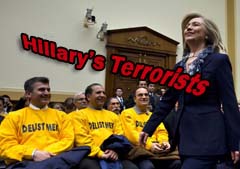Hillary Clinton announces anti-Tehran group People’s Mujahedeen of Iran is no longer on State Department’s list of terror organizations

In Washington, it seems, the difference between a terrorist and a freedom fighter is a multimillion-dollar public relations campaign.
Last week, Secretary of State Hillary Clinton announced that the anti-Tehran group People’s Mujahedeen of Iran (MEK) will no longer be designated a terrorist group after having been placed on the American list 15 years ago for killing U.S. servicemen.
The administration’s change of heart comes after the MEK said it renounced violence in 2003 and recently got the backing of a U.S. Federal Court, which said it has seen no evidence the group is still involved in terrorist activities.
But Clinton’s decision, in part a response to the court’s finding, also comes after a multimillion-dollar campaign on behalf of MEK that has seen a long list of former senior officials and current members of Congress paid lavish fees to make speeches or appearances at MEK functions promoting an end to its terrorist status.
Among those who have been paid to speak on behalf of the MEK’s cause are former New York mayor Rudy Giuliani, former U.S. attorney-general Michael Mukasey, former White House chief of staff Andrew Card, and former U.S. home-land security chief Tom Ridge.
Among those from the U.S. military who have put in appearances are former chair-man of the Joint Chiefs Peter Pace, former Supreme Allied Commander in Europe Wesley Clark, and President Barack Obama’s former national security adviser James Jones.
Former Central Intelligence Agency chiefs James Woolsey, Porter Goss and Michael Hayden have also been paid to speak on MEK platforms.
This, along with unresolved questions about whether MEK has indeed renounced violence – and if so, how recently? – raises the spectre that the Obama administration may be so keen to back Iranian groups opposed to the Tehran regime of Supreme Leader Ayatollah Ali Khamenei that it is not looking too carefully at their credentials or records.
Still fresh in Washington memories is the part Ahmed Chalabi played in feeding false or distorted information about his Iraqi homeland to the receptive audience within the administration of President George W. Bush. As the United States found out after the 2003 invasion of Iraq, there weren’t any weapons of mass destruction, and the invading troops were not welcomed as liberators.
It seems unlikely that the Obama administration would fall for the same kind of blarney from the somewhat sinister husband-and-wife team of Massoud and Maryam Rajavi, who, if several U.S. government reports are to be believed, run MEK as a personality cult complete with brainwashing, brutal internal discipline, and the indoctrination of children.
If Obama is not about to be stampeded into war with Iran by Israeli Prime Minister Benjamin Netanyahu – with the aim of stopping the Tehran regime acquiring the ability to make nuclear weapons – he is unlikely to be impressed by the Rajavis.
Indeed, the history and record of the MEK is so tainted that taking it off the list of terrorist groups will likely do the reputation of the Obama administration no good among the main-stream reformist movement in Iran.
MEK was founded in 1965 by a group of university students as a Marxist Muslim opposition to the Shah of Iran.
Its first terrorist attacks were in 1971, and MEK made special targets of Americans, who were instrumental in keeping the Shah in power.
In 1973, U.S. army Col. Louis Lee Hawkins was shot and killed outside his home in Tehran. In 1975, two U.S. air force officers were killed in an attack on their car. And in 1976, three employees of Rockwell Inter-national were also shot and killed.
MEK joined enthusiastically in the 1979 revolution that ousted the Shah and brought the Islamic Republic to power. The group actively sup-ported the takeover of the U.S. embassy after the coup and the keeping of American diplomats as hostages.
But MEK quickly fell out with the new leader, Ayatollah Khomeini, and killed several of his senior officials in bomb attacks.
In 1986, MEK moved its headquarters to Iraq, where it came under the patronage of Saddam Hussein, fighting for him in his war against Iran and playing a lead role in his murderous campaigns against the Iraqi Kurds.
About 3,000 of the remaining MEK members in Iraq are now in a former American camp outside Baghdad awaiting placement in third countries.
MEK’s attempts to rehabilitate its image started in 2002, when it says it gave the U.S. and its allies the first information about Iran’s nuclear development program.
However, New Yorker magazine journalist Seymour Hersh says that the then-head of the United Nations’ nuclear watch-dog, the International Atomic Energy Agency, Mohamed ElBaradei, told him that the information about Iran’s nuclear program came from the Israeli government and was only channelled through MEK. Much of the evidence of MEK’s continued involvement in violence is circumstantial at best, but one persistent story is that the group’s operatives are working for the Israeli intelligence agency Mossad inside Iran.
In particular, there are many claims that the five Iranian nuclear scientists assassinated since 2007 and the destruction of a missile research centre were operations conducted by MEK for Mossad.
By Jonathan Manthorpe

